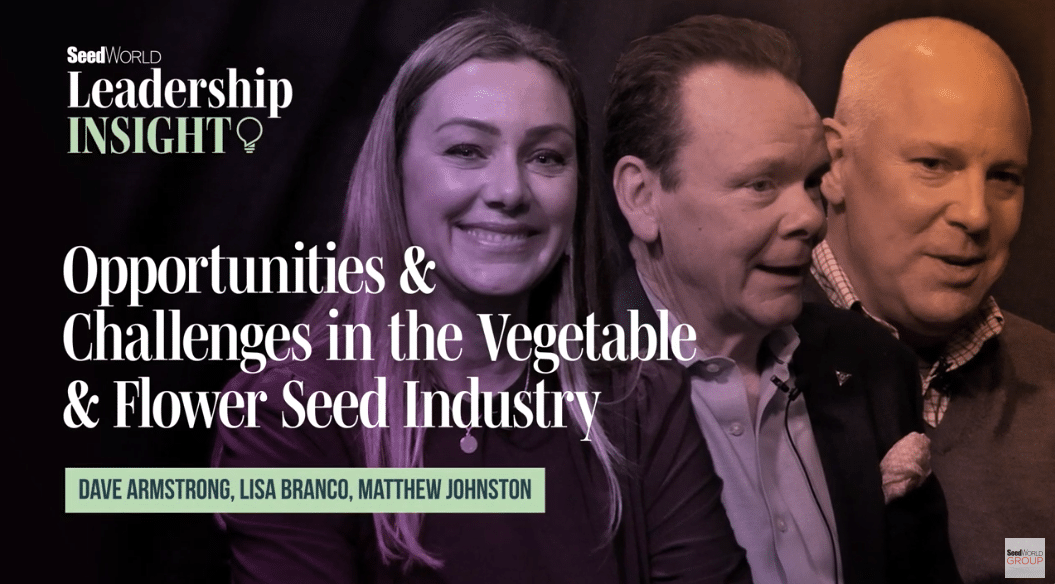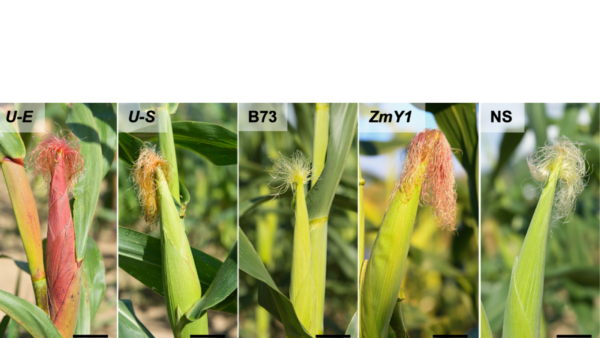From pipeline developments to consumer demand to the factors limiting the release of new vegetable biotech products and the importance of industry initiatives to educate consumers—three industry experts weigh in on the chief issues surrounding the development and release of genetically engineered vegetables.
Biographies:

Bradford’s research has spanned diverse areas of seed science, from seed germination and conservation to mathematical modeling and molecular biology. He has published over 160 peer-reviewed research and extension articles and book chapters and co-edited three books on seed biology. He coauthored a textbook on seed development, germination and dormancy that was published in 2013. As director of the Seed Biotechnology Center, he seeks to create and commercialize new technologies to improve crop performance, quality and sustainability.

Leaving field sales, Langkamp moved to Greensboro, N.C., to become product manager for fungicides and insecticides. With the creation of Novartis, Langkamp moved back into sales as regional sales director for the company’s West Coast business, based in Sacramento, Calif. When Syngenta was formed, he headed the company’s western business unit. Langkamp was named head of vegetables in early 2011.

Sissons has spent his career in the agriculture seed and crop protection industry, and joined Monsanto Canada in 1999. With Monsanto he has held several product development, product management and marketing roles in Canada and the United States, with the last four years in vegetable seed.
Sissons holds a Master of Science in plant science and a Master of Business Administration, both from the University of Manitoba. He resides in Thousand Oaks, Calif., with his wife, Michelle, and three daughters.
SW: Are North American consumers ready for a greater presence of genetically engineered products in the marketplace?
KB: There is a small fraction of consumers who will never be ready for any genetically engineered products, but outside of that group—about 2 to 4 percent of shoppers—I do not think that consumers per se are the barrier to entry of GE products in North America. When asked without prompting, as in surveys by the International Food Information Council, biotechnology is not high on consumers’ concerns about food safety or labeling.
SL: Approximately 95 percent of corn and soybean acres in the United States are currently grown with genetically enhanced seeds, and it is estimated that approximately one-quarter of the food items found in a typical grocery store contain corn in some form, indicating an already significant marketplace presence for foods made from genetically enhanced crops.
Further, the International Food Information Council’s 2012 survey “Consumer Perceptions of Food Technology & Sustainability” reveals the “ majority of Americans, 74 percent, have some awareness of plant biotechnology and almost 40 percent are favorable toward the use of biotechnology in food production … In terms of biotech foods consumers would be likely to purchase based on specific attributes, 77 percent indicated they would be somewhat or very likely to purchase foods produced through biotechnology that required fewer pesticide applications; and 71 percent indicated they would likely purchase biotech foods that provided more healthful fats, such as Omega-3 fatty acids.”
NS: North American consumers are ready for healthy food grown in a better way. The benefits of genetically engineered products in the marketplace are well known since they have been around for well over a decade. I think the question is not if consumers are ready for a greater presence, but how the safety and overall benefits of genetically engineered products are more effectively communicated. This technology gives consumers a healthy supply of food with less inputs and impact on the environment.
“The biggest limiting factor is the cost of development and regulatory approval. From an investment standpoint, it can take around $100 million and ten years or more to develop and obtain regulatory approvals for a new biotech product.” —Norm Sissons
SW: What are the biggest limiting factors to the development and release of biotech products?
KB: The factors are somewhat different for the agronomic crops already using GE crops and the specialty crops in which virtually no GM crops are commercialized. In the agronomic crops, the limiting factors now are the development of more difficult traits such as drought tolerance, nitrogen use efficiency or yield. As GE varieties of these crops are already present in the marketplace, the introduction of further crops is mainly limited by their availability and the economics of their commercialization, including the approvals necessary in countries importing our commodities. In the specialty crops, the expense of meeting regulatory requirements
and the uncertain market acceptance are the major limiting factors. We would likely already have many GE varieties in specialty crops in the market if the costs of meeting the regulatory requirements did not make it uneconomical to even develop these crops. While supermarket and consumer acceptance could also be an issue, consumers do not get a choice until products are in the market, and the products cannot get to the market with the current regulatory hurdles.
SL: There are several factors limiting the development of genetically enhanced products in vegetables. The first is cost, which is about $100 to $200 million for the development, registration and consumer research necessary to ensure a market. Given this cost, and the limited number of acres of vegetables grown, the projected return on investment to bring genetically enhanced vegetable products to market is quite challenging.
Another limiting factor is supply chain complexity and the number of vegetable species and varieties we offer. Bringing genetically enhanced options to market could double the number of products in our portfolio, for example, which would greatly increase supply chain complexity for Syngenta and our channel partners.
NS: The biggest limiting factor is the cost of development and regulatory approval. From an investment standpoint, it can take around $100 million and ten years or more to develop and obtain regulatory approvals for a new biotech product. This level of investment will be very difficult to justify for most vegetable species unless the trait of interest has very high value or very broad acre applicability.
SW: How much influence do consumer trends and acceptance of new breeding techniques play in the decision to develop or not develop a biotech product?
KB: The potential costs and returns for any new products have the final say in whether they are developed and commercialized. In the specialty crops, the costs of meeting the regulatory testing requirements, combined with the “event by event” regulatory approach, make it uneconomical to recover all of those costs via sales of seeds for individual GE varieties. In some markets, such as the EU, consumer attitudes would likely doom a product even if it were marketed. In the United States, I think that consumers in general would largely accept such products. However, dedicated anti-GE groups would mount legal challenges and boycotts that would make consumer opposition appear to be larger than it actually is. The reintroduction of insect-resistant sweet corn to the market and Walmart’s agreement to sell it will be a test of whether activist opposition can overcome the clear but indirect consumer advantages of reduced insecticide use in sweet corn production.
SL: Consumer acceptance plays a significant role. With wheat, for example, Syngenta is creating technology platforms that will increase productivity in an environmentally and economically sustainable way. This includes the development of hybrid wheat production, and using the tools of modern biotechnology to develop native and, eventually, genetically enhanced traits.
We believe that biotechnology will be another tool in our plant breeding toolbox in the mid- to long-term timeframe. We have the capability, for example, for a genetically enhanced Fusarium resistance trait; however, we paused development of this opportunity several years ago. Before we complete the path to commercialization, there have to be clear and unambiguous signals from the value chain—from the grower to the consumer—on how genetically enhanced technology can be enabled to reach the market. We are actively engaged with stakeholders across the value chain to make this determination. In vegetables, consumer acceptance and demand for our products is paramount. Without it, the product will not be accepted by the value chain—or on the farm.
NS: Because it can take around 10 years to bring a new biotech product to market, and it is very costly to do so, we really take into consideration whether or not the value to the people in the value chain—farmers, retailers and consumers—is enough to justify the cost and time spent. Consumer acceptance can be a consideration if there is a non-transgenic option that can provide similar results. For example, in many situations in vegetables we believe recent advances in genetic marker technology and molecular breeding techniques can be a more effective approach than a biotech solution.
|
“In vegetables, consumer acceptance and demand for our products is paramount. Without it, the product will not be accepted by the value chain—or on the farm.” —Scott Langkamp |
SW: How can the seed industry help to change the conversation from “Are products of genetic engineering safe?” to “Wow, that’s a huge step forward”? What is your organization doing to support that concept?
KB: The entire industry, from the breeders and seed producers to the distributors and marketers, must be more visible and publicly supportive of the advantages that can result from using all of the genetic improvement methods available. While mandatory labeling of GE products failed in California in the recent vote, the issue will likely rise again. If labeling is required and companies simply accept a label without actively educating the public on why these crops help in maintaining productivity while reducing the environmental footprint of agriculture, they will cede the opportunity to define the technology to the groups that oppose it. Those groups will seek to frame such a label as a warning, while the food industry should be taking the lead in framing it as evidence of progress in meeting those twin goals of productivity and sustainability. The UC Davis Seed Biotechnology Center has developed a website on biotechnology for sustainability at sbc.ucdavis.edu/B4S/B4S.html that has information and resources on the documented and potential positive impacts on the environment of several applications of agricultural biotechnology.
SL: Syngenta is actively engaged in a broad coalition whose aim is to improve the amount of, and access to, factual information about the benefits of biotech crops. Agricultural biotechnology can improve productivity, secure and improve yields, and produce higher quality crops. Biotechnology advances are critical to the future sustainability of agriculture. If food production is to meet projected population increases over the next generation, genetic enhancement and other biotechnology practices will be central to our success.
NS: In general, there needs to be more education about the safety and benefits of biotech vegetables. I think there is a huge gap in knowledge and to maximize the development of better tasting and more nutritious vegetables, we need to use all of the tools at our disposal. To accomplish this, the whole supply chain—including the seed industry—needs to play an active role in educating consumers. As a company, we actively communicate the benefits and also work through partnerships with third parties. As an example, we continue to advocate the benefits of our Performance Series sweet corn directly and through our supply chain partners.
SW: As it relates to vegetables, can you provide us with some insight into what you see in the pipeline as the next wave of traits is being developed?
KB: We recently reviewed the product innovation and development pipeline for GE specialty crops in Nature Biotechnology entitled, “The Regulatory Bottleneck for Biotech Specialty Crops.” Many potentially useful traits for specialty crops have been demonstrated in proof of concept r
esearch, particularly with respect to pest and disease control, but virtually none are moving through the regulatory process. The global nature of the vegetable seed business presents a daunting challenge for GE varieties due to the myriad of international regulatory environments in which such products would need to be approved.
My own view is that the major advantages for vegetable crops are in the crop protection and post-harvest quality areas, rather than in specific consumer-oriented traits. Many feel that specific advantages for consumers, as in taste or nutritional enhancement, are needed to gain market acceptance of GE vegetables. This could be true for initially penetrating the market, but I think that the biggest advantages for vegetables are in quickly developing new disease resistances or insect management strategies or in adapting crops to climate change—for example, improved stress tolerance—that are not visible to consumers. That is why the industry must take a more active advocacy role in informing the public about these advantages and why they benefit us all.
SL: Syngenta has invested significantly in research and development efforts to understand the genetic make-up of many vegetable species. Our ability to identify genes and the native traits they represent has advanced rapidly. We use this knowledge to develop and bring new products to market that are strong agronomically for growers, but also provide a great eating experience and value chain benefits. Some examples we are working on include a seedless snacking pepper, tomatoes with improved yield and great taste, and melons that are sweet and have a long shelf life. From a genetically enhanced perspective, Syngenta will offer Attribute II sweet corn in 2013, which combines excellent insect protection with herbicide-tolerant traits.
NS: Within vegetable seeds, the vast majority of our R&D focus is on advanced breeding efforts—more than 95 percent, in fact—and that’s where our research focus will remain. We see a lot of opportunity in marker assisted breeding and using better tools to select for consumer traits of interest, such as better taste and improved nutrition. However, we also continue to address grower and supply chain needs by focusing on improved agronomic traits such as disease resistance and plant architecture improvements to facilitate more effective mechanical harvest.
While Monsanto is not working on extensive biotech vegetable research, the overall industry does have a robust pipeline of research efforts in this area. Examples include work in apples, plums, eggplant, dry beans, tomatoes, cabbage, lettuce, cauliflower, among others.














